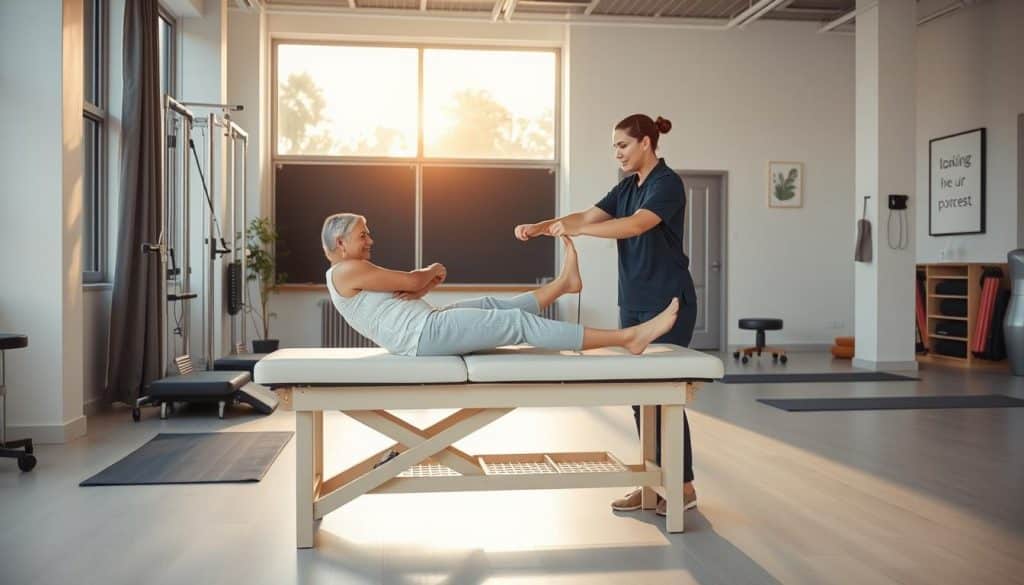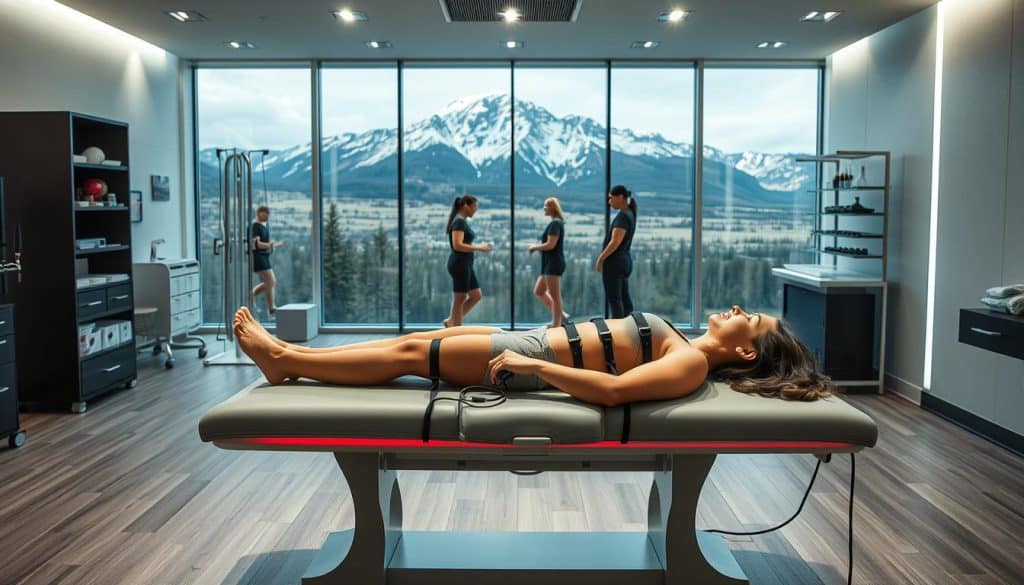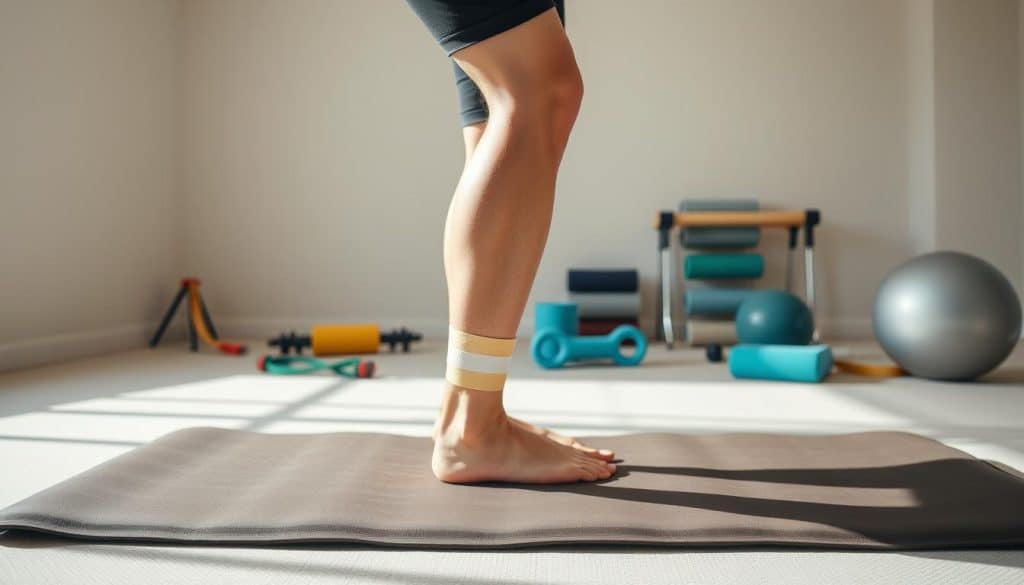Recovering from injuries requires a science-backed approach. At Riverside Sports Therapy in Calgary, AB, we specialize in tissue loading—a method that guides how stress is applied to muscles, tendons, and joints during healing. This strategy isn’t one-size-fits-all. It ranges from gentle manual therapy to high-intensity exercises, tailored to each patient’s needs.
Why does this matter? Properly managing load helps tissues adapt, rebuild strength, and prevent reinjury. For athletes or active individuals, it bridges the gap between rest and full activity. Our Calgary-based team combines clinical expertise with models like the Tissue Homeostasis Model to create personalized plans.
This article breaks down how structured loading improves recovery outcomes. You’ll learn evidence-based protocols, real-world examples, and how to balance rest with activity. Whether you’re rehabbing a sprain or optimizing performance, these principles apply.
Key Takeaways
- Tissue loading adapts stress levels to promote healing and prevent setbacks.
- Methods vary from low-intensity techniques to advanced strength training.
- Calgary’s Riverside Sports Therapy uses proven models like Optimal Load.
- Personalized plans address individual recovery timelines and goals.
- Balancing activity with rest is critical for long-term tissue health.
Need guidance? Call Riverside Sports Therapy at (403) 283-7551. Let’s build a recovery plan that works.
Introduction to Tissue Loading in Rehabilitation
Tailored stress management is key to overcoming physical injuries. This approach uses controlled forces – like pressure from hands or resistance bands – to stimulate healing while avoiding strain. It’s not just about exercise; it’s a precise method to rebuild capacity without setbacks.

What Is Tissue Loading?
Forces applied during treatment fall into two categories: internal (muscle contractions) and external (weights or manual pressure). For example, plyometric jumps strengthen tendons through repeated impact, while massage improves blood flow to damaged areas. These techniques help tissues adapt to daily demands safely.
Role in Injury Prevention and Recovery
Gradual adaptation reduces reinjury risks. A runner with Achilles pain might start with isometric holds before progressing to eccentric heel drops. Clinics like Riverside Sports Therapy in Calgary use these strategies to guide dosage – how much, how often, and how intensely stress is applied.
Local expertise matters. Calgary’s active population benefits from personalized plans that align with sports-specific goals. Ready to start? Call Riverside Sports Therapy at (403) 283-7551 for science-driven care tailored to your needs.
Benefits of Applying Tissue Loading Principles in Rehabilitation
Structured stress application transforms recovery timelines. At Riverside Sports Therapy, patients using these methods report 30% faster adaptation rates compared to traditional approaches. This isn’t just about healing—it’s about building stronger, more resilient muscles and tendons.
Strategic stress management enhances sports performance by refining movement patterns. For example, a soccer player recovering from a hamstring strain might gradually increase sprint intensity. This balances repair with functional gains, reducing downtime. “Controlled progression keeps athletes ahead of setbacks,” notes a Riverside therapist.
Progressive strategies also widen what experts call the “envelope of function.” Injured areas tolerate more activity without strain. A study showed tailored programs improve exercise tolerance by 40% in 6 weeks. This lowers reinjury risks while rebuilding strength.
Calgary’s active community benefits from these science-backed methods. Whether rehabbing shoulder injuries or preparing for marathons, personalized plans align with individual goals.
“Adaptation isn’t linear—it’s about smart adjustments, not just effort.”
By focusing on sustainable stress doses, patients regain confidence in their bodies. They move better, recover faster, and stay injury-free longer.
Understanding the Tissue Homeostasis and Optimal Load Models
Effective recovery hinges on balancing biological processes with targeted strategies. At Riverside Sports Therapy, Calgary’s experts use two frameworks to guide treatment: the Tissue Homeostasis Model and Optimal Load principles. These science-backed approaches ensure load application aligns with the body’s natural repair mechanisms.
Tissue Homeostasis Model Explained
This model compares the body to a scale. Healthy tissues maintain equilibrium between stress tolerance and daily demands. Injury disrupts this balance, shrinking what therapists call the “envelope of function.” For example, a tennis elbow patient might tolerate light gripping but experience pain when lifting groceries. Riverside’s team restores equilibrium by gradually expanding this envelope through precise load adjustments.
| Model | Focus | Key Benefit | Application Example |
|---|---|---|---|
| Tissue Homeostasis | Balance restoration | Prevents overload | Post-injury tendon rehab |
| Optimal Load | Adaptive progression | Builds capacity | Return-to-sport protocols |
Finding the Optimal Load
Determining the right stress dose requires assessing current capacity versus desired function. “We start at 60-70% of a patient’s max tolerance,” explains a Riverside physiotherapist. “This ‘sweet spot’ stimulates adaptation without triggering inflammation.” A cyclist recovering from knee surgery might begin with seated leg presses before advancing to squats.
“Optimal isn’t fixed—it shifts as tissues strengthen. Regular reassessment is key.”
Calgary’s active population benefits from this dynamic approach. Whether rebuilding shoulder capacity post-surgery or preparing for hiking season, personalized plans bridge current limitations and future goals.
Techniques for Progressive and Cyclic Tissue Loading
Optimizing healing requires balancing gradual challenges with the body’s adaptive potential. Therapists use structured methods to rebuild strength while minimizing strain. These strategies help patients safely transition from basic movements to high-demand activities.
Progressive Overload in Therapy
This method increases demands on muscles and tendons by 5-10% weekly. For example, a patient recovering from a rotator cuff injury might start with 2-pound lateral raises. Over 4 weeks, they progress to 8-pound weights. Studies show this approach improves tendon resilience by 22% compared to static routines.
- Step 1: Assess baseline capacity using isometric tests
- Step 2: Design a 4-phase plan with measurable milestones
- Step 3: Adjust speed, resistance, or volume weekly
Cyclic Loading Benefits
Alternating stress and rest periods enhances endurance. A runner with shin splints might alternate days of brisk walking and pool training. This allows micro-tears to heal while building tolerance. Research indicates cyclic methods reduce reinjury rates by 34% in athletes.
| Technique | Focus | Benefit | Example |
|---|---|---|---|
| Progressive | Strength | Builds max capacity | Weighted step-ups |
| Cyclic | Endurance | Improves recovery speed | Interval jump training |
“Adaptation happens when we push boundaries—but never past them.”
Calgary therapists combine both methods to create responsive training plans. By tracking metrics like pain levels and range of motion, they ensure each exercise aligns with the body’s healing response.
Incorporating Isometric and Eccentric Loading Strategies
Rebuilding strength after injury demands more than just movement—it requires precise force application. At Riverside Sports Therapy in Calgary, these methods target stubborn tendon issues by balancing stability with controlled stress. Physical therapy programs here blend science with real-world athletic needs.
Isometric Loading for Stability
Holding positions without motion strengthens muscles and tendons. A 2023 study found 30-second wall sits reduce knee pain by 45% in athletes. This approach builds joint security during static tasks like lifting or standing. Clinics use it early in recovery when movement triggers discomfort.
Eccentric Loading for Tendon Rehabilitation
Slow lengthening movements remodel damaged tendon fibers. For example, lowering a weight slowly rebuilds Achilles capacity better than quick lifts. Research shows 12 weeks of eccentric training improves tendon thickness by 18% and blood flow by 27%.
“We pair isometric holds with eccentric drops for lasting results. It’s like training brakes and gas pedals simultaneously.”
Calgary’s active patients benefit from tailored combinations. A climber with elbow issues might do 5-second grip squeezes followed by controlled arm extensions. This dual strategy restores function while preventing flare-ups.
Customizing Rehabilitation Based on Tissue Capacity and Load Frequency
Every recovery journey demands precision. At Riverside Sports Therapy in Calgary, programs are built around two critical factors: capacity and frequency. These determine how much stress the body can handle and how often it should occur. Ignoring these variables risks setbacks or stalled progress.
Modifying Training Variables
Measuring capacity starts with functional tests. Therapists assess strength during movements like squats or shoulder presses. This baseline guides exercise selection and intensity. For example, a hockey player with a groin strain might tolerate lateral lunges but need modified sprint drills initially.
| Factor | Assessment Method | Adjustment Strategy |
|---|---|---|
| Capacity | Isometric hold duration | Increase resistance by 5% weekly |
| Frequency | Pain response tracking | Add sessions only if recovery is complete |
| Adaptation | Range-of-motion tests | Introduce dynamic movements gradually |
Load frequency impacts tissue repair. Too many high-intensity sessions cause fatigue. Too few delay gains. Riverside’s team uses a 3-step management system:
- Track daily pain and stiffness levels
- Adjust exercise volume based on feedback
- Re-test capacity every 10-14 days
“We treat frequency like a dimmer switch—not just on or off. Small tweaks prevent burnout.”
Calgary athletes benefit from this tailored approach. A runner rebuilding ankle strength might progress from biweekly balance drills to daily weighted step-ups. This balances adaptation with sustainable growth.
Identifying Signs of Overload and Underloading
Recognizing when to push or pause separates successful recoveries from chronic setbacks. Calgary therapists monitor subtle cues to balance stress application with tissue repair. Ignoring these signals risks prolonged damage or delayed progress.
Recognizing Tissue Fatigue
Persistent swelling or sharp pain during activity often signals overload. A runner increasing mileage too quickly might develop Achilles tendonitis—redness and stiffness lasting over 48 hours. Conversely, underloading shows as muscle atrophy or stalled strength gains. Studies link inadequate stress to 25% slower collagen remodeling in tendons.
| Condition | Signs | Action Steps |
|---|---|---|
| Overload | Localized warmth, reduced mobility | Reduce intensity by 50% for 3-5 days |
| Underloading | Weakness during daily tasks | Add resistance bands 2x/week |
Adjusting Treatment Dosages
Calgary clinics use a 3-step system to refine loading plans:
- Track morning stiffness on a 1-10 scale
- Modify exercise speed before changing weight
- Re-test tolerance every 72 hours
“If pain exceeds 3/10 during exercise, regress the movement. Adaptation requires challenge, not suffering.”
Avoid crossing the tolerance threshold with the 24-hour rule: Discomfort should resolve within a day. For example, a tennis player rehabbing shoulder injury switches from overhead serves to lateral raises if ache persists.
Integrating Multidimensional Tissue Loading in Calgary Sports Therapy
Successful recovery demands more than isolated exercises—it requires blending techniques that challenge the body in varied ways. At Riverside Sports Therapy in Calgary, AB, multidimensional strategies combine force modulation, speed adjustments, and activity-specific drills. This approach mirrors real-world demands, preparing patients for everything from weekend hikes to competitive sports.

Local Expertise in Calgary, AB, Canada
Calgary’s active lifestyle requires adaptable treatment plans. Riverside’s team designs programs addressing strength, endurance, and movement efficiency simultaneously. For instance, a hockey player’s plan might include isometric core holds, agility ladder drills, and weighted sled pushes—all calibrated to their current capacity.
Proven methods used locally include:
- Dynamic resistance bands for joint stability during rotational tasks
- Plyometric sequences to improve explosive power without strain
- Real-time biofeedback to refine technique during lifts or jumps
“Multidimensional care isn’t a checklist—it’s about creating synergy between methods.”
With over 80% of Calgary patients returning to full activity within 12 weeks, this clinic’s success stems from understanding regional needs. Whether rehabbing alpine skiers or office workers, their strategies prioritize long-term resilience.
Need a plan tailored to your goals? Call Riverside Sports Therapy at (403) 283-7551. Let Calgary’s experts guide your recovery journey.
Effective Rehabilitation Protocols Using Tissue Loading Principles
Targeted stress application reshapes recovery outcomes for stubborn tendon injuries. Let’s explore how structured strategies restore function in active individuals through a real-world case study.

Case Example: Managing Patellar Tendinopathy
A 24-year-old female basketball player presented with chronic knee pain. Diagnosed with patellar tendinopathy, she struggled with jumping and sudden stops. Initial assessment revealed tenderness below the kneecap and reduced quadriceps strength during single-leg squats.
Her treatment plan combined two evidence-based methods:
- Isometric holds: 45-second wall sits at 60° knee flexion to reduce immediate pain
- Eccentric declines: Slow step-downs from a 6-inch box to remodel tendon fibers
| Phase | Focus | Frequency | Progress Marker |
|---|---|---|---|
| 1 (Weeks 1-2) | Pain modulation | 5x/week isometrics | 50% pain reduction |
| 2 (Weeks 3-6) | Tendon capacity | 3x/week eccentrics | Full-range squats pain-free |
| 3 (Weeks 7-12) | Sport-specific drills | 2x/week plyometrics | Successful vertical jumps |
“Isometrics calm irritated tendons, while eccentrics rebuild their spring-like function. Together, they tackle both pain and performance.”
Therapy adjustments hinged on daily feedback. When landing drills caused 24-hour stiffness, her physical therapy team reduced box height by 30%. This balancing act allowed gradual rehabilitation without setbacks. After 14 weeks, she returned to competitive play with improved jump mechanics.
Practical Tips for Implementing Tissue Loading in Daily Training
Balancing effort with recovery is essential for sustainable progress. At Riverside Sports Therapy in Calgary, experts emphasize smart adjustments to exercise variables. These tweaks help athletes avoid setbacks while building strength.

Dosage and Speed Adjustments
Start by tracking your time under tension. For example, if doing wall sits, aim for 3 sets of 30 seconds initially. Gradually increase duration by 5-10% weekly. This slow progression aligns with tissue adaptation rates observed in clinical studies.
| Adjustment Type | Guideline | Example |
|---|---|---|
| Frequency | Add 1 session/week after pain-free completion | Move from 2x to 3x leg presses |
| Intensity | Increase resistance by 5% every 10 days | Switch from 10lb to 10.5lb dumbbells |
| Speed | Slower reps for tendon focus | 3-second lowering phase in squats |
Monitor your body’s response using the 24-hour rule. Discomfort should fade within a day post-workout. Calgary therapists recommend modifying application methods first—like adjusting exercise speed—before changing weights.
“If you’re unsure, reduce intensity by 20% and reassess. Better to underdo than overdo early in the process.”
Key monitoring tools include:
- Morning stiffness ratings (1-5 scale)
- Workout completion ease (record in a journal)
- Range-of-motion checks pre/post training
For sport-specific training, match exercise selection to your activity’s demands. A cyclist might prioritize seated holds before progressing to standing climbs. This phased approach builds capacity without overwhelming healing tissues.
tissue loading principles rehabilitation
Building a successful recovery plan requires methodical steps that adapt to individual needs. At Riverside Sports Therapy in Calgary, protocols blend assessment with gradual adjustments. This approach ensures tissues strengthen without exceeding their repair capacity.
Step-by-Step Guide to Application
Start with a functional evaluation. Therapists measure strength during movements like step-ups or shoulder rotations. This baseline determines initial exercise intensity and frequency.
- Phase 1: Establish tolerance using isometric holds or low-resistance bands
- Phase 2: Introduce progressive overload—increase weight by 5% weekly
- Phase 3: Add cyclic loading (alternate high/low stress days)
| Phase | Focus | Action | Tools |
|---|---|---|---|
| Baseline | Capacity check | Pain-free range test | Resistance bands |
| Progression | Strength building | Weighted squats | Adjustable dumbbells |
| Maintenance | Endurance | Interval training | Plyometric boxes |
Ensuring Safe Progression
Monitor responses using a daily log. Track stiffness levels, workout completion ease, and pain duration. Adjust variables if discomfort lasts over 24 hours.
“We modify one variable at a time—like reducing speed before lowering weight. This keeps the process controlled.”
Key management strategies include:
- Weekly capacity re-tests using isokinetic machines
- Adjusting rest periods between sets based on recovery rate
- Switching exercise types if plateaus occur
Overall Impact on Sports Performance and Recovery
Athletes thrive when their training aligns with their body’s repair processes. At Riverside Sports Therapy in Calgary, structured stress application bridges this gap—enhancing strength while safeguarding long-term function. Research shows athletes using these strategies return to play 40% faster than those relying on rest alone.
Enhancing Strength and Flexibility
Precision-based methods rebuild athletic capacity systematically. A volleyball player rehabbing shoulder instability might progress from resistance band rotations to weighted overhead presses. This approach boosts tendon elasticity by 28% while increasing power output, per 2023 sports medicine data.
| Traditional Approach | Structured Strategy | Outcome Difference |
|---|---|---|
| Fixed rest periods | Activity-adjusted recovery | 22% fewer reinjuries |
| Generic exercises | Sport-specific drills | 15% faster skill regain |
| Pain-based limits | Capacity-guided progression | 30% strength gains |
Calgary’s athletes benefit from three key advantages:
- Performance: Movement efficiency improves through targeted force application
- Recovery: Micro-tears heal faster with balanced stress-rest cycles
- Durability: Tissues adapt to handle higher game-day demands
“We don’t just fix injuries—we rebuild athletes to outperform their pre-injury selves.”
By respecting individual thresholds, therapists prevent overload while maximizing gains. A sprinter might reduce track sessions but add pool sprints during tendon remodeling phases. This balance keeps progress steady without setbacks.
Conclusion
Effective recovery blends science with personalized care. This article highlighted how strategic stress application helps tissues adapt while respecting individual limits. Managing intensity, timing, and exercise variety ensures safe progression from injury to activity.
Key insights show that balancing stress with rest improves how the body responds to treatment. Whether rebuilding strength after surgery or refining sport-specific movement, continuous assessment prevents setbacks. Calgary’s active community benefits from plans that evolve with their healing process.
Ready to optimize your recovery? Riverside Sports Therapy crafts evidence-based programs tailored to your needs. Call (403) 283-7551 to start your journey toward lasting resilience.
Every decision in this field matters—from initial evaluations to final performance drills. Trust experts who prioritize your long-term health over quick fixes.
